Table of contents:
How to blur your background in Zoom on a desktop (Windows or Mac)
Requirements for the blur effect on Zoom
How to blur your Zoom background before a meeting
How to blur your background during a Zoom meeting
How to blur your Zoom background on the mobile app
Zoom blur effect vs Zoom virtual backgrounds
Zoom alternative for blurred and virtual backgrounds
Troubleshooting: How to fix the blur effect when it’s not working on Zoom
Key takeaways:
- Before meetings you can blur your Zoom background by going to settings.
- In a Zoom meeting you’ll need to navigate to your video settings to do the same.
- To control the blur level and to use blur on a virtual background you’ll need another meeting app like Riverside.
We’ve all been there: joining a virtual meeting and feeling self-conscious about the messy room behind us.
Instead of turning off your camera, you can blur your Zoom background to keep the focus on you and minimize distractions.
Wondering how to blur the background in Zoom meetings?
We’ll guide you through how to apply the Zoom blur background effect - and troubleshoot any issues that can keep it from working.
Table of contents
How to blur your background in Zoom on a desktop (Windows or Mac)
Requirements for the blur effect on Zoom
How to blur your Zoom background before a meeting
How to blur your background during a Zoom meeting
How to blur your Zoom background on the mobile app
Zoom blur effect vs Zoom virtual backgrounds
Troubleshooting: How to fix the blur effect when it’s not working on Zoom
How to blur your background in Zoom on a desktop (Windows or Mac)
Requirements for the blur effect on Zoom
Before we discuss the steps to create a blurred Zoom background, we’ll discuss the hardware and software requirements to access this feature.
Hardware requirements
- Processor: Windows devices need Intel i3, i5, i7, or equivalent AMD Ryzen processors. MacOS systems need 4th generation or later.
- Graphics card: A dedicated graphics card like NVIDIA, Intel, or AMD will ensure the blur effect looks as natural as possible.
- RAM: You need at least 4 GB RAM for seamless performance with a blurred Zoom background.
Wondering how to find these details on your system? Here’s how.
On a Windows device, go to Settings > System to get all the details about your processor, graphics card, and RAM.
On a Mac, click the Apple icon on your navigation menu and press “About This Mac” to find similar information.
Software requirements
- Zoom version: Check whether you’re using latest version of Zoom by clicking on your profile icon. Press the “Check for updates” button to find and install the latest updates.
- Operating system: If you’re working on a Windows device, you need Windows 7 or later in the 64-bit edition. For macOS systems, you need OS 10.13 or later.
- Camera permissions: Make sure your camera is working and that you have granted the necessary permissions for the Zoom app. Go to your Zoom Settings > Video to test your camera and connect to a different camera device.
Once you’ve checked all these requirements, you’re ready to use the Zoom blur background feature in your meetings.
Pro tip: Want a lightweight Zoom alternative that works without all these complicated system requirements? Check out Riverside, a versatile platform for creating studio-quality content with advanced producer controls, a built-in editor, and seamless collaboration
How to blur your Zoom background before a meeting
Now, let’s learn how to blur the Zoom background on Mac and Windows systems.
To get started, log in and set up your Zoom account. Then, you can follow these steps to blur your Zoom background before joining a meeting.
Step 1: Locate the “Settings” button on the top-right corner of your screen and click on it to access your account settings.

Step 2: Find the “Background & Effects” tab on the left panel in the Settings window.

Step 3: Choose the “Blur” option to apply the effect.

If you’ve already applied a virtual background, the blur option will replace this background with a blurred visual of your actual background.
How to blur your background during a Zoom meeting
So, you know how to blur your background in Zoom before you enter a meeting.
But what if you want to switch on your camera and blur the background after you’ve joined a meeting? Here’s how you can do it:
Step 1: Join the Zoom meeting and navigate to the bottom-left corner of your Zoom app. You’ll find the “Start Video” button. Press the small arrow icon on this button.
Step 2: Choose “Blur my background” from the options in this list.
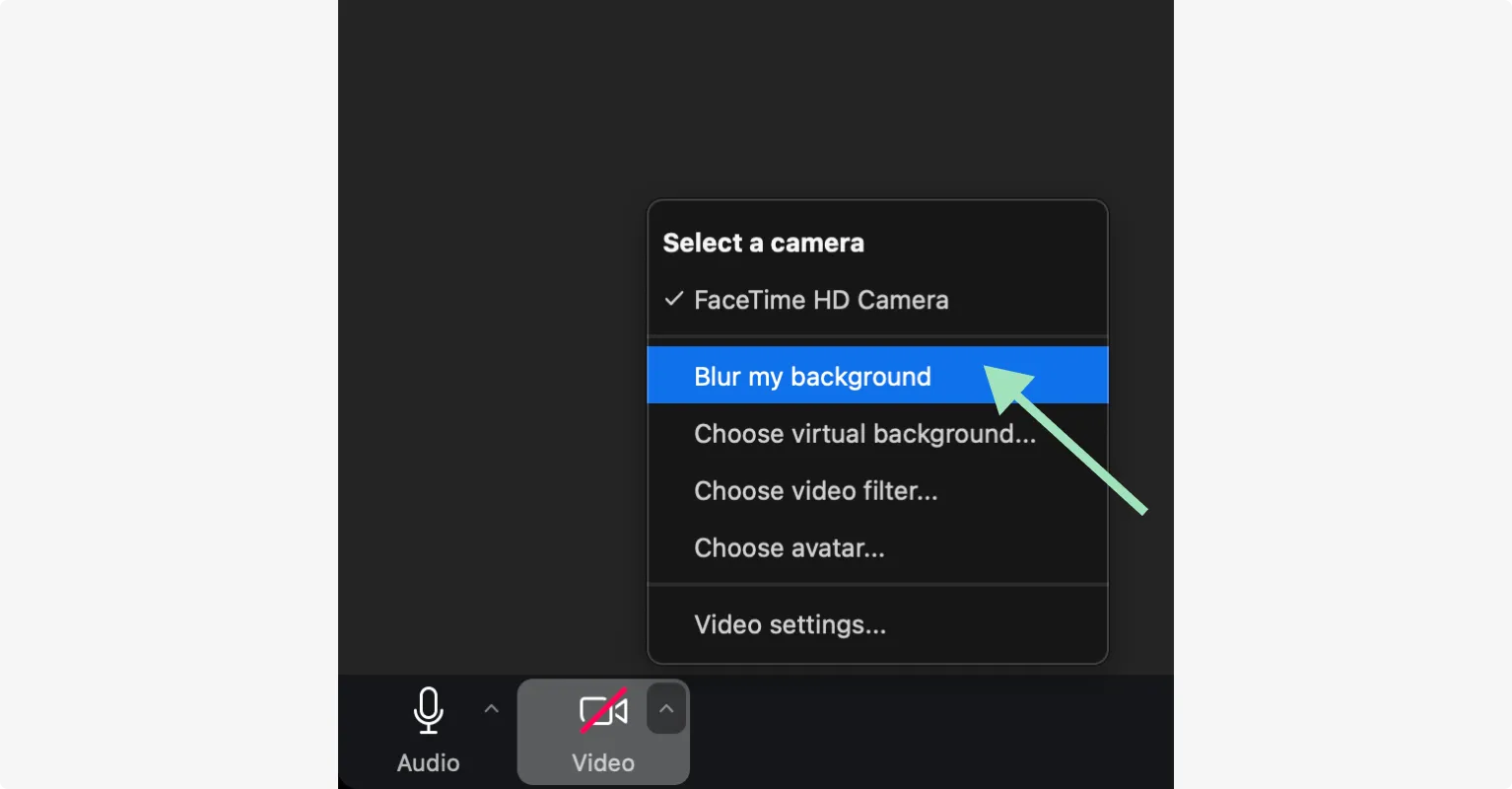
This will instantly blur your background, whether your camera is enabled or not. You can also access other features like a virtual background, video filter, and avatar to jazz up your video.
How to blur your Zoom background on the mobile app
You can also blur your background using the Zoom mobile app. Here’s how to do it on both Android and iOS mobile devices.
Step 1: Launch the Zoom app on your phone and log into your account.
Step 2: Join a meeting to apply the blur effect. You can create a temporary meeting by clicking “New meeting” or join your actual meeting.
Step 3: Find the control bar at the bottom and scroll toward the right. Click “More” to find the background effects.
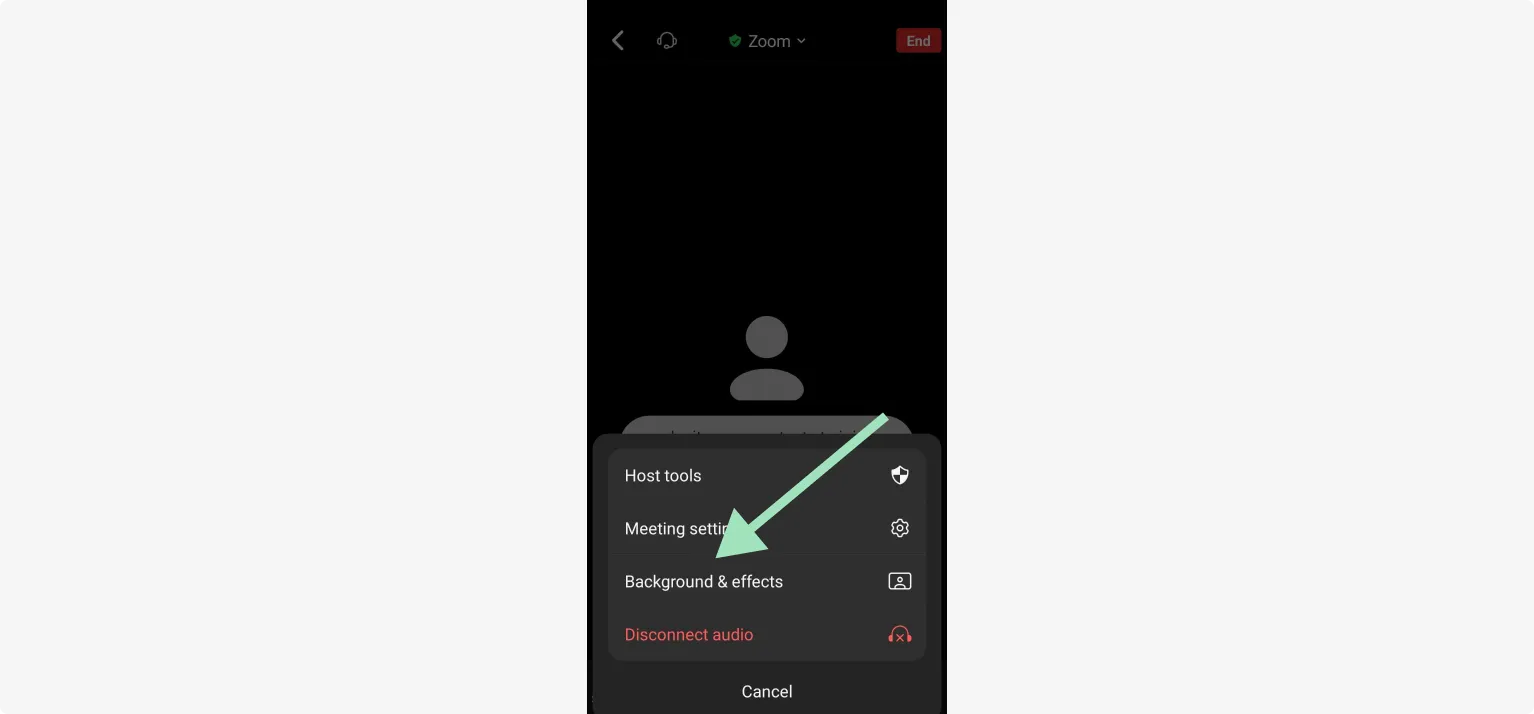
Step 4: Choose “Backgrounds and effects”. Now you’ll have the option to blue your back, add a virtual effect or even an avatar.
Click on “Blur” to switch it on.
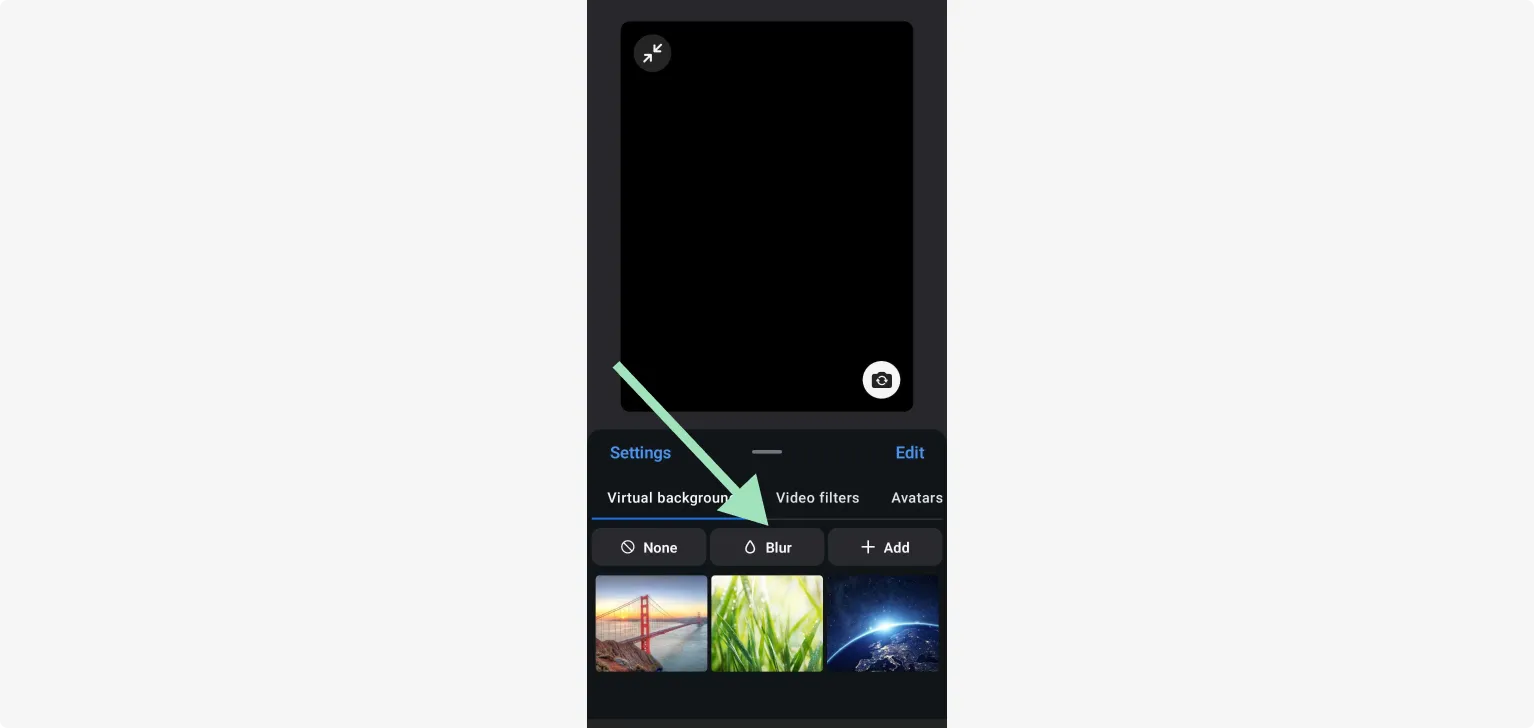
Zoom blur effect vs Zoom virtual backgrounds
Another way to hide your background on Zoom is by applying virtual backgrounds.
Zoom offers a few built-in virtual backgrounds. You can also add your own images or videos to create a custom background. This is great for incorporating your branding into calls with external stakeholders or adding some fun to team-building meetings. It also makes a great backdrop when recording a Zoom webinar.
Here’s how you can change your Zoom background.
How to change your Zoom background to a virtual background
Step 1: Join a new meeting and navigate to the “Start Video” button. Click on the arrow icon and press “Choose Virtual Background.”
This directs you to background and effects settings.
Step 2: In the “Background & Effects” tab to find all virtual backgrounds available by default. You can choose from any of the five available options.
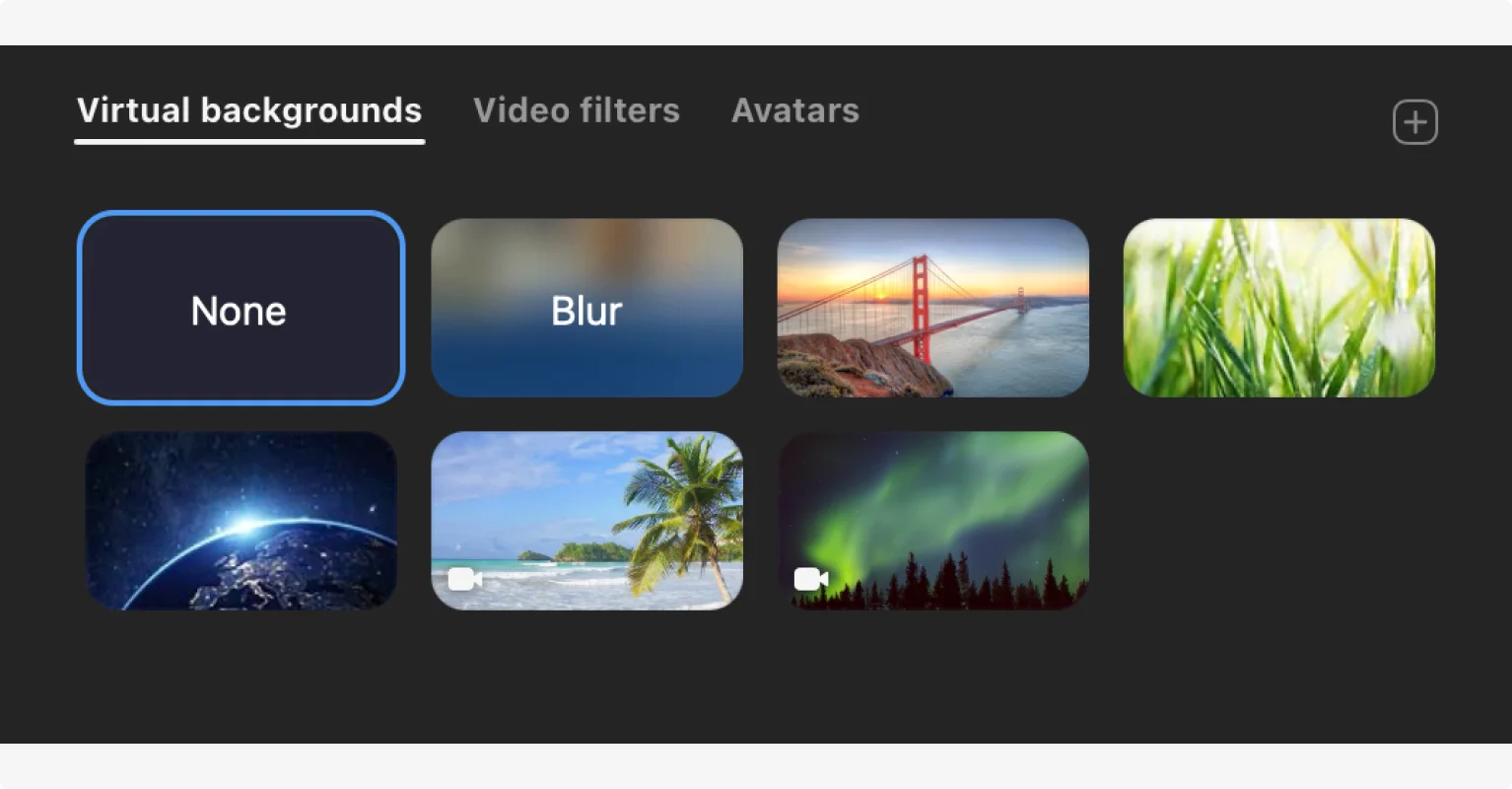
Step 3: Zoom also lets you upload your own media to create a custom background. Click on the "+" to add an image or video to this background library.
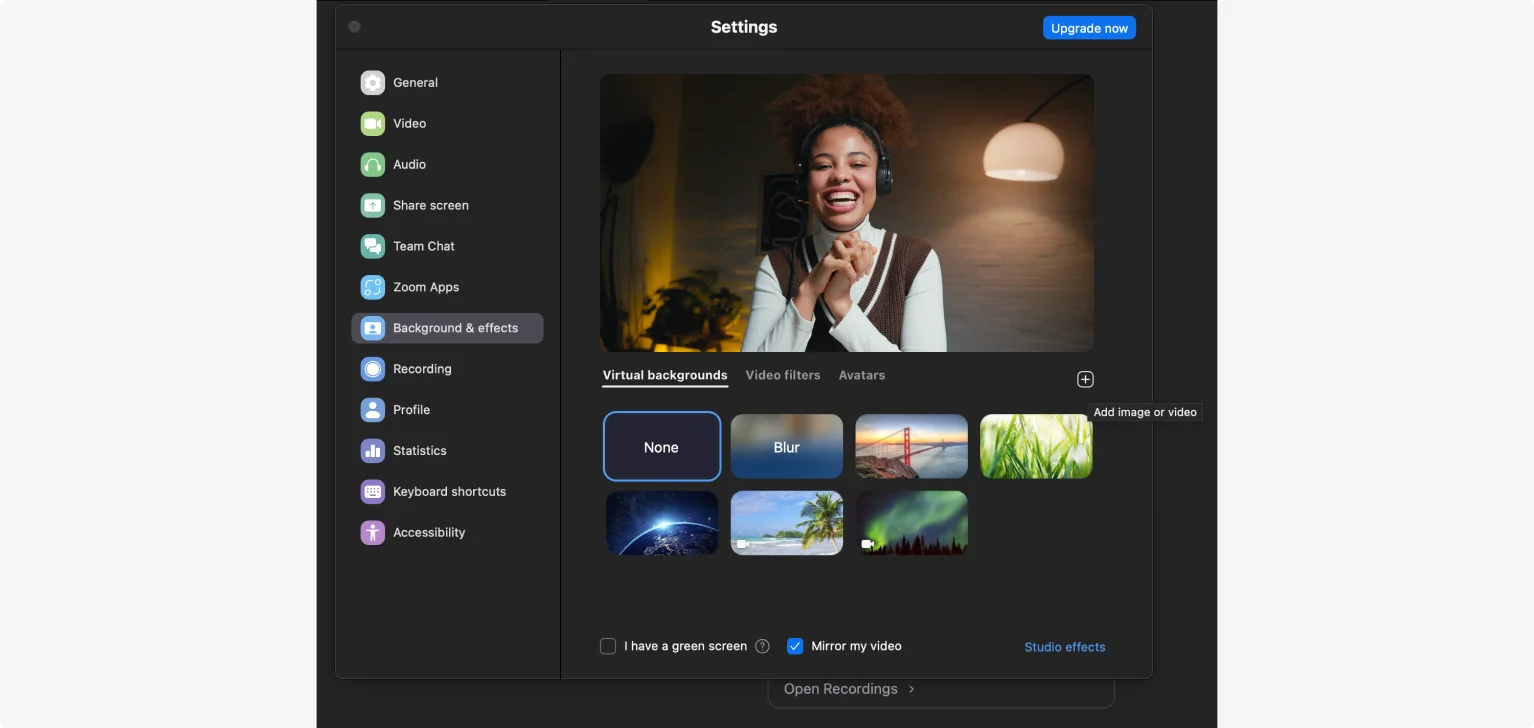
Step 4: Click on “Studio Effects” to finetune your image.
These effects enhance how you look on camera. You can improve your eyebrows, add a mustache or beard, and apply lip color.
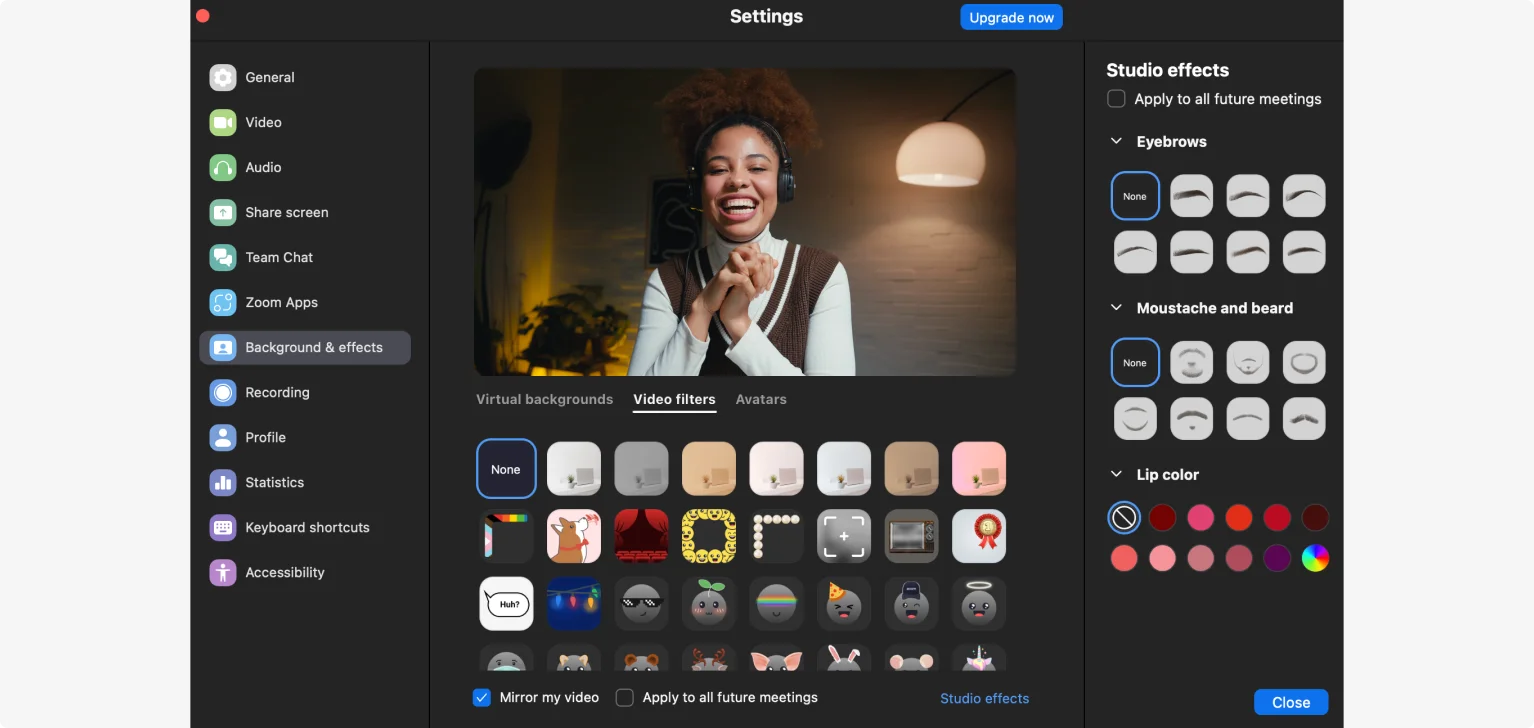
Zoom alternative for blurred and virtual backgrounds
Unlike Zoom, Riverside gives you two options to choose the intensity of the blur background effect: a mild blur effect and an intense blur effect. You can also choose from a collection of Riverside’s virtual backgrounds, specially curated for different types of events and themes.
.webp)
Troubleshooting: How to fix the blur effect when it’s not working on Zoom
While applying the blurred Zoom background effect is easy enough, there are some reasons why it may not work.
The result? You have to show a messy background in your calls or keep your webcam off.
Here’s a list of possible issues that can keep blur from working in Zoom and how to fix them.
Outdated Zoom version
One of the most common reasons the blur effect doesn’t work is that you’re using an outdated Zoom app.
How to fix: Click on your profile picture and find the “Check for updates” option. Then, update your app to install the latest version and reapply the blur background effect.
You can also find the “Zoom Workplace updates” option in the General settings tab. Enable this to ensure that new updates are automatically installed.
Incompatible hardware
Zoom’s blurred background only works on devices that meet the specific systems requirements we detailed at the top of this article.
If your device doesn’t fulfill these requirements, you won’t be able to blur your Zoom background.
How to fix: Refer to the systems requirements list shared at the beginning of this article. Then, check your device’s specifications. Go to Settings > System on a Windows device or clicking the Apple icon and “About This Mac” on a Mac device. If your hardware isn’t compatible, switch to a different device.
Insufficient system bandwidth
Your Zoom app can fail to blur your video effectively when it doesn’t get enough resources to run.
This happens when you use multiple high-resource applications together. This can slow down your system’s performance and even crash your computer.
How to fix: Close unnecessary applications that may be consuming significant system resources. You can also restart your device and enable the blur effect again.
Disabled virtual background
Another reason why your Zoom blur effect isn’t working can be because your virtual backgrounds are disabled. This can happen when you change your camera or video input.
How to fix: You have to check and reconfigure your background settings whenever your virtual background is disabled.
Go to the settings on your Zoom account and go to the “Video” tab. Then, apply any of the virtual backgrounds or the blur effect to fix this issue.
Disabled by admin on a team account
If your Zoom account is linked to a company account, your app settings are moderated by the account administrator. You might not be able to apply the blur background effect if the admin has disabled the background settings.
How to fix: Speak to your team’s Zoom account admin to enable the background settings. Once they apply the blur effect, it’ll be visible for all users.
FAQs on How to Blur Your Zoom Background
Still unsure about how to blur or apply a Zoom virtual background? Here are our answers to a few frequently asked questions.
Why blur your background in Zoom?
A blurred background gives you more privacy in Zoom meetings. You can obscure personal or sensitive information and reduce distractions during meetings. It also creates a cleaner and more professional look, especially if you’re working in a messy office or your bedroom!
Why doesn't my Zoom have the blur background option?
There are three common reasons why the blur background option is not available on Zoom:
- Outdated app: The blur feature is available in Zoom version 5.5.0 or later. You might be using an outdated version.
- Incompatible hardware: Your device might not be compatible with specific system requirements for Zoom’s blur effect to work.
- Disabled background: You might have disabled virtual backgrounds in your account settings.
You can check out our troubleshooting section to sort these issues out.
Why is my Zoom background covering my face?
Zoom’s blur-background technology is designed to automatically register your face and determine which areas of the screen to blur. But it isn’t always accurate.
If you notice that Zoom is blurring a part or all of your face, the background color may be too close to your skin tone.
Here, a simple solution is to change your location or create a background that effectively contrasts against your skin. A green screen would actually be best for this.
Does Zoom's background blur feature affect video quality?
No, Zoom’s blurred background will not affect your video quality. That said, your video might get pixelated if your internet connectivity is slow or you’re running multiple apps consuming your system’s resources.
Note: You can stream and record your videos in a much better quality (even with a slow internet connection) with Riverside. And apply the blur effect or a virtual background just like Zoom.
Can I use virtual backgrounds and background blur simultaneously in Zoom?
No, you can’t use virtual backgrounds with the blur effect. Blur is also a type of virtual background on Zoom. That’s why you have to choose between a virtual background (image/video) and a blurred background.
If you’d like to use a virtual background and blur at the same time, consider another video call software like Riverside.
Is it free to blur the Zoom background in meetings?
Yes, you can blur the Zoom background before or during meetings for free.
Final thoughts
Is Zoom the only digital communication tool that can provide you with scope for professional calls and meetings? No!
If you’re searching for an alternative Zoom software option, Riverside is a great choice. Riverside’s studio-quality recording and editing tools allow you to host engaging online calls and capture impactful video content.
Get started with Riverside today!



















.webp)


